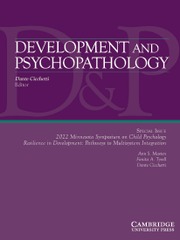Crossref Citations
This article has been cited by the following publications. This list is generated based on data provided by
Crossref.
Alink, Lenneke R. A.
Cyr, Chantal
and
Madigan, Sheri
2019.
The effect of maltreatment experiences on maltreating and dysfunctional parenting: A search for mechanisms.
Development and Psychopathology,
Vol. 31,
Issue. 1,
p.
1.
Dandy, Emma
Knibbs, Jacqueline
and
Gilbey, Felicity
2020.
‘Mad, sad and bad’ to ‘Dad’: care-experienced men’s experiences of fatherhood.
Adoption & Fostering,
Vol. 44,
Issue. 3,
p.
285.
Greene, Carolyn A.
Haisley, Lauren
Wallace, Cara
and
Ford, Julian D.
2020.
Intergenerational effects of childhood maltreatment: A systematic review of the parenting practices of adult survivors of childhood abuse, neglect, and violence.
Clinical Psychology Review,
Vol. 80,
Issue. ,
p.
101891.
Fuchs, Anna
Lunkenheimer, Erika
and
Lobo, Frances
2021.
Individual differences in parent and child average RSA and parent psychological distress influence parent-child RSA synchrony.
Biological Psychology,
Vol. 161,
Issue. ,
p.
108077.
Kaliush, Parisa R.
Terrell, Sarah
Vlisides‐Henry, Robert D.
Lin, Betty
Neff, Dylan
Shakiba, Nila
Conradt, Elisabeth
and
Crowell, Sheila E.
2021.
Influences of adversity across the lifespan on respiratory sinus arrhythmia during pregnancy.
Developmental Psychobiology,
Vol. 63,
Issue. 6,
Piotrowski, Konrad
and
Matsumura, Kenta
2021.
How many parents regret having children and how it is linked to their personality and health: Two studies with national samples in Poland.
PLOS ONE,
Vol. 16,
Issue. 7,
p.
e0254163.
Piotrowski, Konrad
2021.
Parental identity status in emerging and early adulthood, personality, and well‐being: A cluster analytic approach.
Scandinavian Journal of Psychology,
Vol. 62,
Issue. 6,
p.
820.
Bruce, Diane
and
Hackett, Simon S.
2021.
Developing art therapy practice within perinatal parent-infant mental health.
International Journal of Art Therapy,
Vol. 26,
Issue. 3,
p.
111.
Alyousefi‐van Dijk, Kim
van der Knaap, Noa
Buisman, Renate S.M.
Horstman, Lisa I.
Lotz, Anna M.
Riem, Madelon M. E.
Schuengel, Carlo
van IJzendoorn, Marinus H.
and
Bakermans‐Kranenburg, Marian J.
2021.
White matter integrity moderates the relation between experienced childhood maltreatment and fathers’ behavioral response to infant crying.
Developmental Psychobiology,
Vol. 63,
Issue. 5,
p.
1399.
Fuchs, Anna
Lunkenheimer, Erika
and
Brown, Kayla
2021.
Parental history of childhood maltreatment and child average RSA shape parent–child RSA synchrony.
Developmental Psychobiology,
Vol. 63,
Issue. 6,
Tyra, Alexandra T.
Cook, Taryn E.
Young, Danielle A.
Hurley, Page E.
Oosterhoff, Benjamin J.
John-Henderson, Neha A.
and
Ginty, Annie T.
2021.
Adverse childhood experiences, sex, and cardiovascular habituation to repeated stress.
Biological Psychology,
Vol. 165,
Issue. ,
p.
108175.
Loeb, Emily L.
Davis, Alida A.
Narr, Rachel K.
Uchino, Bert N.
Kent de Grey, Robert G.
and
Allen, Joseph P.
2021.
The developmental precursors of blunted cardiovascular responses to stress.
Developmental Psychobiology,
Vol. 63,
Issue. 2,
p.
247.
Nowak, Amanda L.
Braungart-Rieker, Julia M.
and
Kuo, Patty X.
2022.
Social support moderates the relation between childhood trauma and prenatal depressive symptoms in adolescent mothers.
Journal of Reproductive and Infant Psychology,
Vol. 40,
Issue. 6,
p.
644.
Rokach, Ami
and
Chan, Sybil
2022.
The Effect of COVID on Child Maltreatment: A Review.
Journal of Psychology and Psychotherapy Research,
Vol. 9,
Issue. ,
p.
22.
Souch, Alistair J.
Jones, Ian R.
Shelton, Katherine H.M.
and
Waters, Cerith S.
2022.
Maternal childhood maltreatment and perinatal outcomes: A systematic review.
Journal of Affective Disorders,
Vol. 302,
Issue. ,
p.
139.
Molina, Abigail Palmer
Skowron, Elizabeth A.
and
Hackman, Daniel A.
2022.
Maternal Intimate Partner Violence Exposure and Autonomic Reactivity: Associations With Positive Parenting.
Journal of Interpersonal Violence,
Vol. 37,
Issue. 3-4,
p.
997.
Kim, Andrew Wooyoung
Nyengerai, Tawanda
and
Mendenhall, Emily
2022.
Evaluating the mental health impacts of the COVID-19 pandemic: perceived risk of COVID-19 infection and childhood trauma predict adult depressive symptoms in urban South Africa.
Psychological Medicine,
Vol. 52,
Issue. 8,
p.
1587.
Singh Solorzano, Claudio
and
Grano, Caterina
2023.
Predicting postpartum depressive symptoms by evaluating self-report autonomic nervous system reactivity during pregnancy.
Journal of Psychosomatic Research,
Vol. 174,
Issue. ,
p.
111484.
Shin, Sunny H.
Tomlinson, Camie A.
Nelson-Hence, Devin
and
Ksinan Jiskrova, Gabriela
2023.
Understanding the Intergenerational Cycle of Trauma and Violence: Maternal Adverse Childhood Experiences and Parent-to-Child Aggression Risk.
Journal of Interpersonal Violence,
Vol. 38,
Issue. 5-6,
p.
4998.
Bogat, G. Anne
Levendosky, Alytia A.
and
Cochran, Kara
2023.
Developmental Consequences of Intimate Partner Violence on Children.
Annual Review of Clinical Psychology,
Vol. 19,
Issue. 1,
p.
303.




